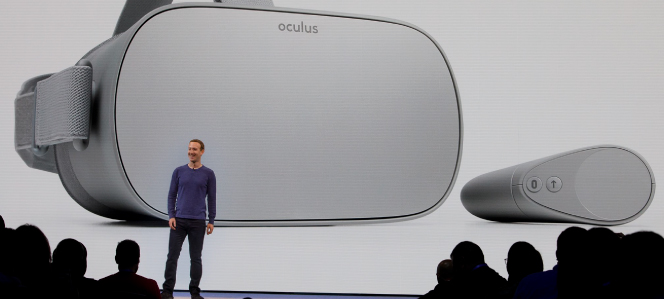For years, millennials have been hand-holding baby boomer family members, co-workers, and churchgoers as they explain (and not without a splash of condescension) how the digital world works. To do this type that, to send that click this. We were there for Sega Genesis, the Hamster Dance, and AOL Instant Messenger. We know our world back to front.
Well, I recently had the opportunity to try VR (virtual reality) for the first time using the Oculus headset, and I realized something: it won’t be long before we are the ones sheepishly asking for help. Technology is moving so quickly that the lifespan of digital natives will soon mirror that of the mayfly.
When you see video or pictures of people using VR, you tend to imagine an intense video game. But VR is more like a hallucination or an illusion, one that tricks the brain into receiving the virtual as the real. Of course, you know that this grainy pastiche of perception isn’t real. But everywhere you look—up, down, left, right, front, behind—you are totally immersed in a new visual field with the matching sounds, and the experience is disorienting. I entered a skydiving simulation, looked down to see nothing but sky, and froze, a primordial fear of plummeting welling up in my brain and body. VR is aptly named, because more than anything that came before it, it feels real.
With Facebook’s acquisition of Oculus a few years ago, it’s clear that giving users an amazing virtual experience rather than just a product or a tool is where innovators want to go next. And as people get used to it (as I started to after just a few games), digital creators will look to push the boundaries and incorporate VR beyond entertainment and into medicine, business, education, travel—you name it.
But then a curious thing happened. A few days after experiencing Oculus, I came across a new study from Blue Cross Blue Shield that found that more than 9 million commercially insured people in the U.S. suffer from major depression, a 33-percent jump from 2013 through 2016. The rise in rates of depression was substantial for people ages 35 and up, but especially pronounced for young people: 47 percent for millennials and 63 percent for those 12 to 17 years old.
A number of factors might be playing into this rise, but a 2017 study from researchers at San Diego State and Florida State universities found a strong correlation between depression and increased screen time. The study showed that “nearly half of teens who spent five or more hours in front of screens daily experienced thoughts of suicide or prolonged periods of hopelessness or sadness.”
Why, in the age of amazing tools like iPhones and Oculus headsets, do people feel so hopeless and sad? Is it the kinds of messages young people are seeing on their screen? Is it the message of the medium itself? Is it the whole odd world around them that vanishes when that comforting digital haze flicks on, or the way that world rushes back in when they eventually have to extinguish it?
Or is it somehow all of the above?
Walker Percy, a writer whose father and grandfather both committed suicide, was attuned to the reality of depression in the modern world. And this is how he saw it: “You are depressed because you have every reason to be depressed. No member of the other two million species which inhabit the earth—and who are luckily exempt from depression—would fail to be depressed if it lived the life you lead. You live in a deranged age—more deranged than usual, because despite great scientific and technological advances, man has not the faintest idea of who he is or what he is doing.”
Percy’s point is this: if someone with a why can bear almost any bad how, isn’t it equally true that someone with almost every good how still can’t bear having no why? Science and technology are certainly good things, but all the entertainment, information, and friend updates in the world don’t add up to the peace of a why; in fact, they only makes its absence more glaring and awful.
Henry Kissinger made this point in a recent piece sounding the alarm on artificial intelligence. Despite our great how of self-taught AI, he argues, we have forgotten our need for a grounding and governing why. And where AI is concerned, the danger is more than a sunken psyche: it’s a collapsed social order. Whether that danger is real or imagined, VR and AI are on our doorstep, and we’ve only just begun to see what screen time can do for us—and to us.
Where does the Christian faith fit in this picture? Some, like Kissinger, assume that it doesn’t; that an “Age of Reason” has superseded the “Age of Religion.” Catholics know better—our faith has always harmonized with reason, and in fact established the conditions for the possibility of modern science—but is that message reaching people? Many in the Christian churches generally, but the Catholic Church in particular, have been mind-bogglingly slow in adapting to the digital world and meeting young people where they are. We’ve been reactive at best, and it shows.
But what happens when smartphones suddenly look as quaint as rotary phones, and young people go from being attached to their phones to literally immersed in digital worlds?
The Church has to do a better job presenting itself and the why of the Gospel to a culture increasingly held captive to screen time. It has to make the joy of its truth and goodness and beauty known to young people who assume faith is a dead option because no one told them otherwise. It has to be proactive.
The alternative might just be giving this fallout of digital gloom the last word.
